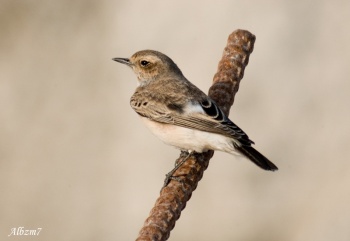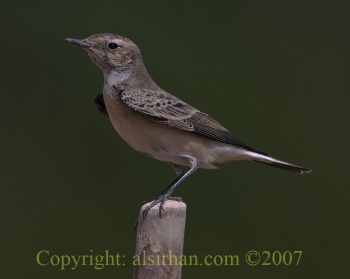(References updated) |
m (→External Links: updated VSearch and GSearch) |
||
| (9 intermediate revisions by 3 users not shown) | |||
| Line 1: | Line 1: | ||
| − | [[Image: | + | [[Image:1050 1072 1084 1077 1085 1082 1072 P5283531.jpg|thumb|550px|right|Photo © by {{user|Oleg+Chernyshov|Oleg Chernyshov}} <br />Inya, Altay Republic, West Siberia, [[Russia]], May 2012]] |
;[[:Category:Oenanthe|Oenanthe]] pleschanka | ;[[:Category:Oenanthe|Oenanthe]] pleschanka | ||
==Identification== | ==Identification== | ||
| − | + | [[Image:DSC 0005-4.jpg|thumb|350px|right|Female<br />Photo © by {{user|Albzm7|Albzm7}}<br />Abu Dhabi, [[UAE]], September 2006]] | |
| − | + | 14·5–16 cm (5¾-6¼ in)<br /> | |
| − | It is the '''females''' which cause the greatest problems, especially in autumn or winter when they can look almost identical to some [[Black-eared Wheatear]]s. Pied Wheatears though have more obvious pale fringes on the upperparts (which are usually a colder, greyer brown) and if they show any orangey colour on the breast it will merge gradually into the black or plain brown of the throat.<br /> | + | '''Males''' look strikingly black-and-white, with white undertail [[Topography#General Anatomy|coverts]], no white in the wing in flight, an anchor-shaped tail pattern (frequently looking broken), and often, a buff or yellowish flush on the upper breast.<br /> |
| + | First winter males may show a combination of blackish throat and orangey-colouring on the breast, suggesting [[Cyprus Pied Wheatear]] but with less contrast between these two areas and with a much paler back. Cyprus Wheatear has a wider black terminal band on the tail.<br /> | ||
| + | |||
| + | It is the '''females''' which cause the greatest problems, especially in autumn or winter when they can look almost identical to some [[Eastern Black-eared Wheatear]]s and possibly also [[Western Black-eared Wheatear]]s. Pied Wheatears though have more obvious pale fringes on the upperparts (which are usually a colder, greyer brown) and if they show any orangey colour on the breast it will merge gradually into the black or plain brown of the throat.<br /> | ||
'''Identification of younger birds''' of this species versus [[Black-eared Wheatear]] is discussed in a [http://www.birdforum.net/showthread.php?t=101414 thread] in the Identification forum | '''Identification of younger birds''' of this species versus [[Black-eared Wheatear]] is discussed in a [http://www.birdforum.net/showthread.php?t=101414 thread] in the Identification forum | ||
==Distribution== | ==Distribution== | ||
| − | [[Image:Pied Wheat MG 1910 3.jpg|thumb|350px|right|1st Winter Male<br />Photo by {{user|alsirhan|alsirhan}}<br /> [[Kuwait]], Tulha, October 2007]] | + | [[Image:Pied Wheat MG 1910 3.jpg|thumb|350px|right|1st Winter Male<br />Photo © by {{user|alsirhan|alsirhan}}<br /> [[Kuwait]], Tulha, October 2007]] |
| − | Breeds in dry, stony areas in the far east of [[Europe]] from the Black Sea coasts in the northeast of [[Bulgaria]] through eastern [[Romania]], [[Moldova]], southern [[Ukraine]] and southernmost [[Russia]], and across southwest and central [[Asia]] from [[Kazakhstan]] and easternmost [[Turkey]] east to northern [[China]]. Migrates through southwest Asia (mostly east of [[Jordan]], few west to [[Israel]]) and northeast [[Africa]], and winters in southwestern [[Arabia]] and tropical eastern [[Africa]], south as far as [[Tanzania]]. | + | Breeds in dry, stony areas in the far east of [[Europe]] from the Black Sea coasts in the northeast of [[Bulgaria]] through eastern [[Romania]], [[Moldova]], southern [[Ukraine]] and southernmost [[Russia]], and across southwest and central [[Asia]] from [[Kazakhstan]] and easternmost [[Turkey]] east to northern [[China]]. |
| + | |||
| + | Migrates through southwest Asia (mostly east of [[Jordan]], few west to [[Israel]]) and northeast [[Africa]], and winters in southwestern [[Arabia]] and tropical eastern [[Africa]], south as far as [[Tanzania]]. | ||
The non-Russian European total of 3-6,000 pairs are found almost entirely in Romania, plus some in Moldova and Bulgaria. Over 100 000 pairs also breed from the Crimean Penisula eastwards into Asia. | The non-Russian European total of 3-6,000 pairs are found almost entirely in Romania, plus some in Moldova and Bulgaria. Over 100 000 pairs also breed from the Crimean Penisula eastwards into Asia. | ||
| Line 15: | Line 20: | ||
==Taxonomy== | ==Taxonomy== | ||
| + | [[Image:A00 3438 800.jpg|thumb|350px|right|Moulting into winter plumage <br />Photo © by {{user|AJDH|AJDH}}<br />Badaan Farm, [[Bahrain]], October 2008]] | ||
This is a [[Dictionary_M-O#M|monotypic]] species<sup>[[#References|[1]]]</sup>, but with two morphs, black-throated and white-throated, the latter formerly sometimes treated as a subspecies ''O. p. vittata''. The black-throated morph dominates, comprising 92-98% of the population<sup>[[#References|[2]]]</sup>. | This is a [[Dictionary_M-O#M|monotypic]] species<sup>[[#References|[1]]]</sup>, but with two morphs, black-throated and white-throated, the latter formerly sometimes treated as a subspecies ''O. p. vittata''. The black-throated morph dominates, comprising 92-98% of the population<sup>[[#References|[2]]]</sup>. | ||
| Line 20: | Line 26: | ||
==Habitat== | ==Habitat== | ||
| − | + | Arid rocky and scrubby areas especially at sites by the coast such as cliff-tops. Desert and semi-desert. | |
==Behaviour== | ==Behaviour== | ||
====Diet==== | ====Diet==== | ||
| − | The diet consists mostly of insects. | + | The diet consists mostly of insects, such as ants and beetles, with the addition of autumn fruit. |
====Breeding==== | ====Breeding==== | ||
| − | + | They nest on open, stony, sparsely vegetated habitats, laying 4-6 eggs in a rock crevice under a boulder. | |
====Vocalisation==== | ====Vocalisation==== | ||
| − | + | {{ Audio|Oenanthe pleschanka (song).mp3 }} | |
| − | + | ||
| + | ==Gallery== | ||
| + | Click on photo for larger image | ||
| + | <gallery> | ||
| + | Image:Pied3.jpg|Female<br />Photo © by {{user|Howard+King|Howard King}}<br />Busaiteen, [[Bahrain]], September 2009 | ||
| + | Image:Wheatear Pied edit A3987.jpg|Male winter plumage<br />Photo © by {{user|rdavis|rdavis}}<br />South of Yabelo, [[Ethiopia]], January 2015 | ||
| + | </gallery> | ||
==References== | ==References== | ||
| − | #{{Ref- | + | #{{Ref-Clements6thAug18}}#{{Ref-HBWVol10}}#Avibase |
#Wikipedia | #Wikipedia | ||
#BF Member observations | #BF Member observations | ||
#[http://www.birdforum.net/showthread.php?p=2445905 Birdforum] thread discussing id of Cyprus and Pied Wheatears | #[http://www.birdforum.net/showthread.php?p=2445905 Birdforum] thread discussing id of Cyprus and Pied Wheatears | ||
| + | #Collins Bird Guide ISBN 0 00 219728 6 | ||
{{ref}} | {{ref}} | ||
==External Links== | ==External Links== | ||
| − | {{GSearch|Oenanthe | + | {{GSearch|"Oenanthe pleschanka" {{!}} "Pied Wheatear"}} |
| + | <br /> | ||
| + | {{VSearch|"Oenanthe pleschanka" {{!}} "Pied Wheatear", video}} | ||
| + | {{GS-checked}} | ||
| + | <br /> | ||
<br /> | <br /> | ||
| − | |||
[[Category:Birds]][[Category:Bird Songs]][[Category:Oenanthe]] [[Category:Videos]] | [[Category:Birds]][[Category:Bird Songs]][[Category:Oenanthe]] [[Category:Videos]] | ||
Latest revision as of 13:55, 30 May 2023
- Oenanthe pleschanka
Identification
14·5–16 cm (5¾-6¼ in)
Males look strikingly black-and-white, with white undertail coverts, no white in the wing in flight, an anchor-shaped tail pattern (frequently looking broken), and often, a buff or yellowish flush on the upper breast.
First winter males may show a combination of blackish throat and orangey-colouring on the breast, suggesting Cyprus Pied Wheatear but with less contrast between these two areas and with a much paler back. Cyprus Wheatear has a wider black terminal band on the tail.
It is the females which cause the greatest problems, especially in autumn or winter when they can look almost identical to some Eastern Black-eared Wheatears and possibly also Western Black-eared Wheatears. Pied Wheatears though have more obvious pale fringes on the upperparts (which are usually a colder, greyer brown) and if they show any orangey colour on the breast it will merge gradually into the black or plain brown of the throat.
Identification of younger birds of this species versus Black-eared Wheatear is discussed in a thread in the Identification forum
Distribution
Breeds in dry, stony areas in the far east of Europe from the Black Sea coasts in the northeast of Bulgaria through eastern Romania, Moldova, southern Ukraine and southernmost Russia, and across southwest and central Asia from Kazakhstan and easternmost Turkey east to northern China.
Migrates through southwest Asia (mostly east of Jordan, few west to Israel) and northeast Africa, and winters in southwestern Arabia and tropical eastern Africa, south as far as Tanzania.
The non-Russian European total of 3-6,000 pairs are found almost entirely in Romania, plus some in Moldova and Bulgaria. Over 100 000 pairs also breed from the Crimean Penisula eastwards into Asia.
Widely recorded as a vagrant, in e.g. Britain, Finland, Hungary, Yugoslavia, Serbia, Montenegro, Greece (including Crete, Lesvos, Rhodes), Malta, Libya, Egypt, Nepal, Pakistan, India, and South Africa.
Taxonomy
This is a monotypic species[1], but with two morphs, black-throated and white-throated, the latter formerly sometimes treated as a subspecies O. p. vittata. The black-throated morph dominates, comprising 92-98% of the population[2].
Formerly classed as a member of the Thrush family (Turdidae), now generally considered to be an Old-World Flycatcher (Family Muscicapidae).
Habitat
Arid rocky and scrubby areas especially at sites by the coast such as cliff-tops. Desert and semi-desert.
Behaviour
Diet
The diet consists mostly of insects, such as ants and beetles, with the addition of autumn fruit.
Breeding
They nest on open, stony, sparsely vegetated habitats, laying 4-6 eggs in a rock crevice under a boulder.
Vocalisation
Gallery
Click on photo for larger image
Female
Photo © by Howard King
Busaiteen, Bahrain, September 2009
References
- Clements, J. F., T. S. Schulenberg, M. J. Iliff, D. Roberson, T. A. Fredericks, B. L. Sullivan, and C. L. Wood. 2018. The eBird/Clements checklist of birds of the world: v2018. Downloaded from http://www.birds.cornell.edu/clementschecklist/download/
- Del Hoyo, J, A Elliot, and D Christie, eds. 2005. Handbook of the Birds of the World. Volume 10: Cuckoo-Shrikes to Thrushes. Barcelona: Lynx Edicions. ISBN 978-8487334726
- Avibase
- Wikipedia
- BF Member observations
- Birdforum thread discussing id of Cyprus and Pied Wheatears
- Collins Bird Guide ISBN 0 00 219728 6
Recommended Citation
- BirdForum Opus contributors. (2024) Pied Wheatear. In: BirdForum, the forum for wild birds and birding. Retrieved 18 May 2024 from https://www.birdforum.net/opus/Pied_Wheatear
External Links
GSearch checked for 2020 platform.









